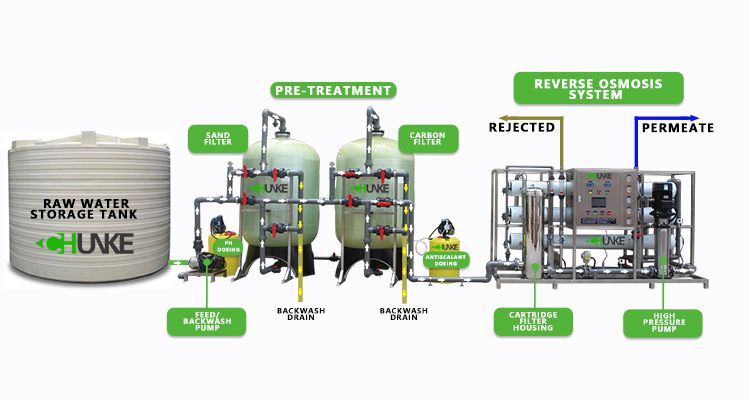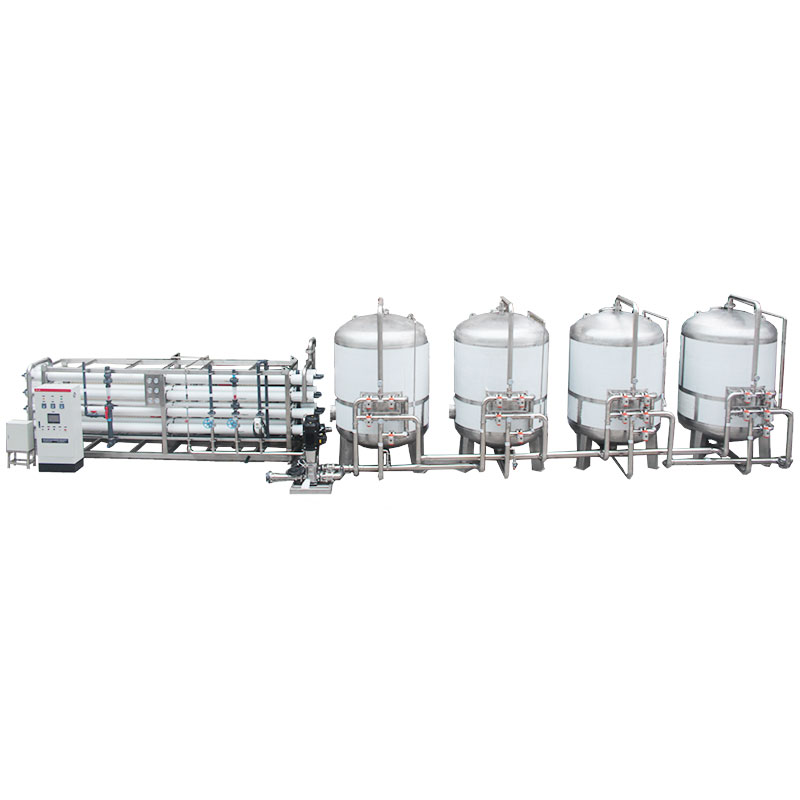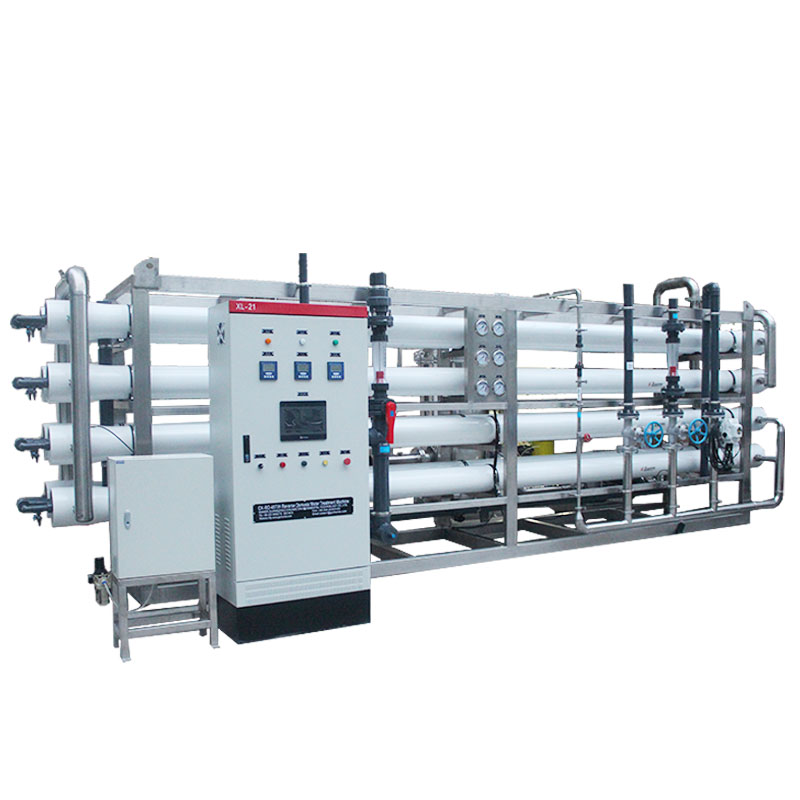Why do reverse osmosis systems waste so much water?
As an efficient water treatment technology, reverse osmosis (RO) systems are widely used in household, industrial and municipal water treatment. However, many people encounter a problem when using reverse osmosis systems: a large amount of wastewater. Why do reverse osmosis systems produce so much wastewater?
This article will take a deep look at the working principle of reverse osmosis systems, the reasons for wastewater generation and the scientific principles behind it.

How does a reverse osmosis system work?
To understand why reverse osmosis systems produce wastewater, you first need to understand its basic working principle. Reverse osmosis is a technology that uses semipermeable membranes to separate solutes and solvents. During the reverse osmosis process, raw water passes through a semipermeable membrane under high pressure, and water molecules pass through the membrane into the clean water side, while impurities, ions and microorganisms dissolved in the water are trapped on the other side of the membrane to form concentrated water.
The micropore diameter of the semipermeable membrane is very small, only about 0.0001 microns, which enables it to effectively block most dissolved solids and pollutants and only allow water molecules to pass through. This process can not only remove suspended matter, bacteria and viruses in the water, but also remove soluble salts and organic matter to generate high-purity clean water.

What is the cause of wastewater generation?
In the reverse osmosis system, the generation of wastewater is an inevitable result. This is mainly due to the following reasons:
2.1 Increased impurity concentration:
As the reverse osmosis process proceeds, the semipermeable membrane continuously intercepts solutes and pollutants in the water on the concentrated water side. Over time, the impurity concentration in the concentrated water gradually increases. If there is no wastewater discharge, these impurities will gradually accumulate and eventually block the micropores of the membrane, causing the membrane to fail. Therefore, the reverse osmosis system must discharge wastewater to keep the impurity concentration in the concentrated water within a controllable range to ensure the normal operation of the system and the long life of the membrane.
2.2 Membrane self-cleaning requirements:
The semipermeable membrane will gradually accumulate impurities during long-term operation, resulting in a decrease in membrane flux and a decrease in clean water production. In order to maintain the efficient working state of the membrane, the reverse osmosis system needs to perform regular self-cleaning of the membrane. This process is usually achieved through wastewater discharge, and the flow of wastewater can take away impurities on the surface of the membrane to prevent it from clogging and contamination.
2.3 Limitations of water recovery rate:
The water recovery rate of a reverse osmosis system refers to what proportion of raw water is converted into clean water. Generally speaking, the water recovery rate of a domestic reverse osmosis system is about 20% to 50%, which means that for every liter of clean water produced, about 2 to 4 liters of wastewater are discharged. This ratio is mainly limited by membrane technology, system design and operating conditions. Improving the water recovery rate usually leads to an increased risk of membrane fouling and clogging, which in turn affects the stability and life of the system.

What factors affect the amount of wastewater?
The amount of wastewater generated by a reverse osmosis system is not only related to its working principle, but also affected by multiple factors:
3.1 Raw water quality:
The quality of raw water has an important impact on the amount of wastewater from a reverse osmosis system. The higher the dissolved solids, contaminants and hardness in the raw water, the more frequently the system needs to discharge wastewater to prevent membrane clogging. Therefore, the worse the raw water quality, the greater the amount of wastewater is usually.
3.2 System design and configuration:
The design and configuration of the reverse osmosis system also affects the amount of wastewater. For example, the membrane area of the system, the pressure of the pump, the discharge method of concentrated water, etc. will affect the amount of wastewater generated. Efficient system design can reduce the amount of wastewater to a certain extent and improve the water recovery rate.
3.3 Operating conditions:
Operating conditions such as water inlet pressure, temperature and flow rate will also affect the amount of wastewater. Generally speaking, higher water inlet pressure and lower water inlet temperature can improve the water recovery rate of the system and reduce the amount of wastewater. However, the adjustment of these conditions needs to be carried out under the premise of ensuring the safety of the membrane and the stability of the system.
How to treat and utilize wastewater?
Although the reverse osmosis system will produce a large amount of wastewater, this wastewater is not useless. Reasonable wastewater treatment and utilization can reduce waste to a certain extent and improve resource utilization efficiency.
4.1 Wastewater recycling:
Although wastewater contains a high concentration of impurities, it can still be used as non-drinking water in many cases. For example, wastewater can be used for household water such as flushing toilets, watering flowers and plants, cleaning, etc., reducing the consumption of tap water. In the industrial field, wastewater can be used for cooling circulating water, cleaning water, etc., thereby reducing water costs.
4.2 Wastewater treatment:
Before discharge, wastewater can be treated by simple treatment processes such as sedimentation and filtration to remove some impurities before reuse. For application scenarios with large wastewater volume, advanced oxidation, membrane bioreactor and other technologies can also be used for deep treatment to meet the reuse standards.
4.3 System optimization:
By optimizing the design and operating conditions of the reverse osmosis system, the amount of wastewater can be reduced to a certain extent. For example, a multi-stage reverse osmosis system can be used to recover concentrated water multiple times to improve the overall water recovery rate and reduce the amount of wastewater. In addition, regular maintenance and cleaning of membrane components to maintain efficient operation of the system can also help reduce the amount of wastewater.

Summary
The reverse osmosis system occupies an important position in the modern water treatment process due to its efficient water purification ability. However, its high wastewater volume has always been the focus of attention. The generation of wastewater is the result of the working principle and technical limitations of the reverse osmosis system, and is related to many factors such as raw water quality, system design and operating conditions.
When selecting and using a reverse osmosis system, users should comprehensively consider water quality, system performance and economic costs, reasonably adjust operating conditions, and take effective wastewater treatment measures to achieve efficient, energy-saving and environmentally friendly water treatment goals.




